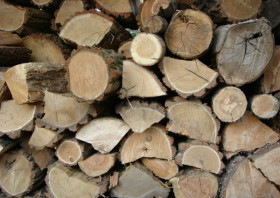Use seasoned firewood for a safer, hotter fire
Burning improperly seasoned firewood reduced your fire’s heating potential and puts your home at risk for increased air pollution, mold exposure and chimney fires. But what is properly seasoned firewood, and what can you do to make sure the wood you’ve chopped or purchased is ready for burning?
What is seasoned firewood?
Wood comprises a series of tubes that carry water from a tree’s roots to its branches. In fact, freshly cut wood contains about 45 percent water. Wood that is ideal for burning has been left to rest for at least six months, bringing its water content to between 20 and 25 percent.
Why is seasoned firewood important?
When firewood isn’t seasoned properly and moisture remains, it poses a risk to your home and reduced the efficiency of your fire. Wet firewood produces a lot of smoke. That smoke introduces more air pollution to your home, especially if you have an open-hearth fireplace. Even worse, the dense smoke put off by unseasoned firewood sticks more readily to your chimney’s walls. That can build up into dangerous-highly flammable creosote, which puts your home at danger for a chimney fire. Additionally, when wet wood is stacked, it leads to the potential for mold. Even if you don’t notice mold growing on your firewood, when moldy firewood is burned, it can send mold spores air born into your home.
Finally, when you light wet firewood, you’re not producing as warm of a fire as you could be. Much of the fire’s energy goes into evaporating the water from the firewood, meaning your fire is no longer heating your home as efficiently as it could.
How do I properly season my firewood?
If you’re chopping your own firewood or purchasing unseasoned firewood, you will need to store it properly to make sure it’s seasoned and ready to go for your fireplace or wood stove. First, logs should be cut to the appropriate length for your fireplace, generally 3 inches shorter than the firebox. Then, it should be split to the proper width of 3 to 6 inches. Wood should be stacked in a sunny place where the wind can blow through the woodpile. Don’t cover your seasoning woodpile, as the elements will help dry it over time. Once the wood is seasoned, it should be covered from rain and snow, as dried wood can reabsorb water.
How can I tell if my wood is properly seasoned?
There are several ways to tell if wood is dried and ready for a fire. First, you will notice cracks in the wood. Seasoned wood should feel lighter, and if you hit two pieces of wood together, you should hear a drum-like sound, while wet wood will let off a dull thud. The bark on dried wood will become loose, and the color will be yellow or brown, rather than a creamy white.
If you’re still not sure if your firewood is properly seasoned, try burning a few logs. Seasoned firewood will light easily and let off the pleasant crackling sound associated with fireplaces, while wet wood will be difficult to light and will hiss as the water inside turns to steam.

